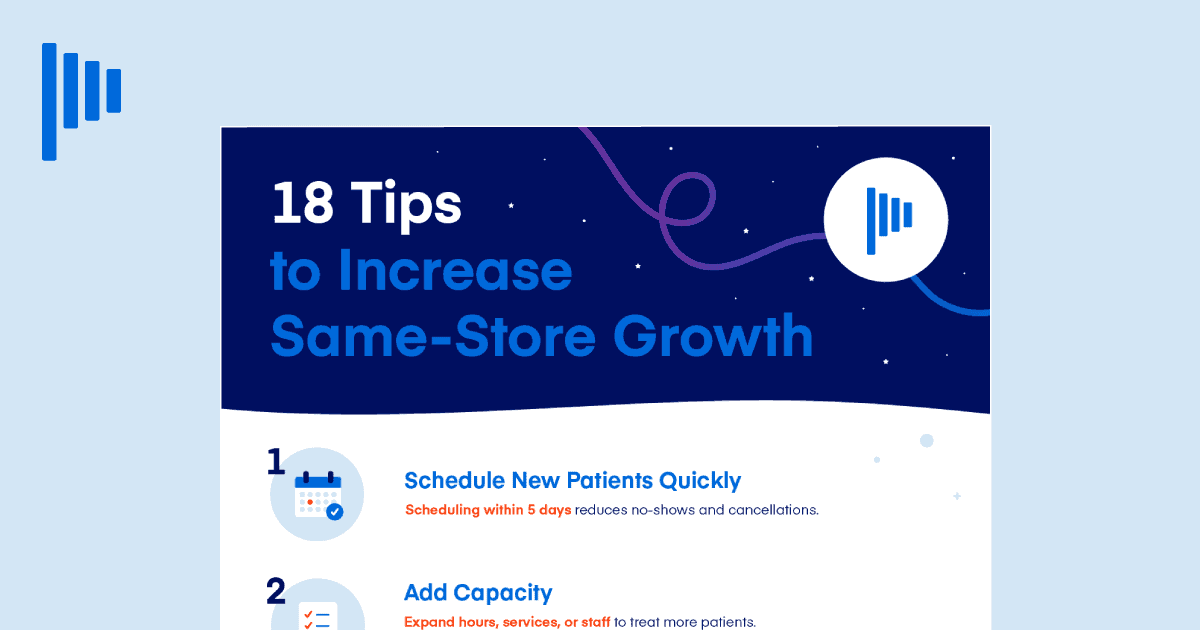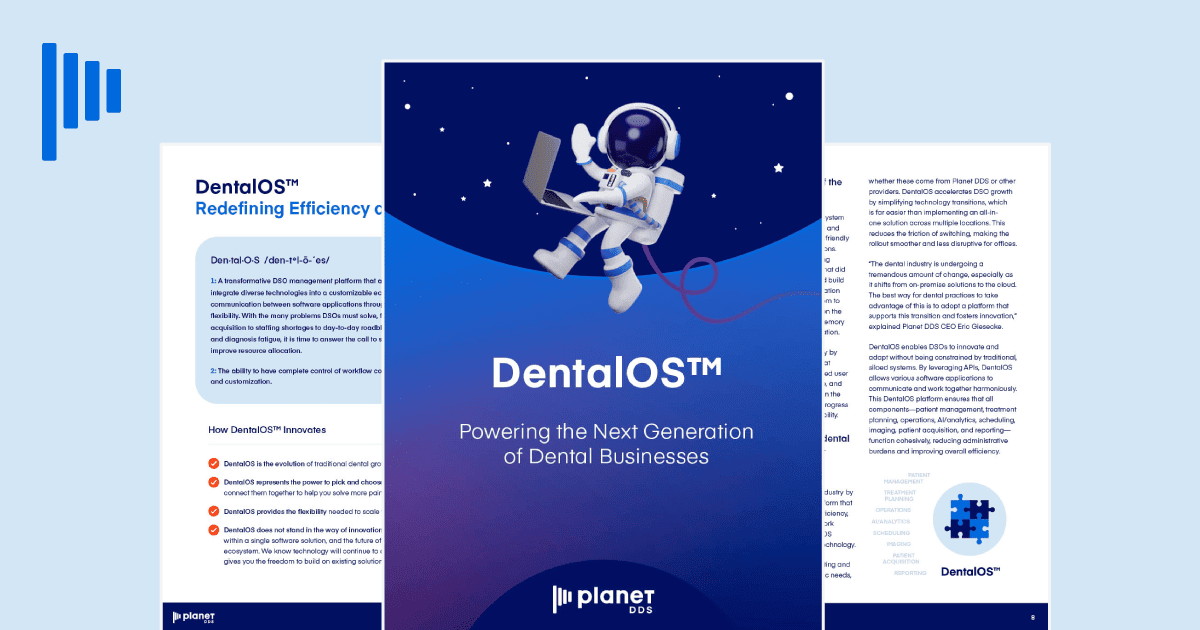Top 5 Operational Challenges for DSOs Managing Multiple Dental Practices

Just like any business, DSOs have their own unique set of challenges. Managing multiple dental practices is much a different feat than running just one dental office. Identifying the top operational challenges of DSOs allows you to determine which solutions will your organization run as smoothly as possible. If you want learn how to run a successful dental practice, read on!
We outlined the top five challenges of running a DSO and how to combat them:
- Adopting a Franchise Model
Just like you cannot run a fast-food chain the same way you would run a local burger joint, you cannot manage your DSO like a private dental practice. You have to adopt a franchise model to handle all the moving parts. It is just too difficult to manage multiple offices that all have different daily operations. Failing to adapt to a franchise model will cost you financially and result in unpredictable patient experiences.
Does your DSO have a standard process of when and how you collect payments? How often do you file claims? Do you follow the estimated portion from insurance benefits verification? No two practices run exactly the same as one another, and experienced employees are typically hardwired to perform routine tasks in a very specific way. Some methods are more efficient than others. There is not necessarily a correct way to perform these tasks, but having all your locations do them the same is critical to managing your organization effectively and executing a cohesive brand.
Creating an acquisition plan to ease the practice into your organization will help staff transition more easily to help maintain productivity. The transition on the clinical team may be easier since dentists and hygienists have more or less the same duties no matter where they work. Investing in training for the administrative staff right off the bat will also ensure that each employee understands the new protocols and can perform them correctly. Initiating a productivity reporting system is valuable to ensure the completion of daily, weekly, and monthly tasks while also keeping employees accountable. Using a centralized practice management and imaging solution will also enable your DSO to better track and reach production goals.
- Accurately Estimating Provider Turnover
Some of the most prominent reasons dentists join DSOs are because they are close to retirement or want to take on a more part-time role. It is a common struggle for DSOs to replace these providers or hire more staff members to keep up with patient demand. There are 60.84 per 100,000 US population, and the unemployment rate for dentists is only 0.4%. This will likely leave you with a small pool of candidates. Furthermore, many hygienists, assistants, and front desk staff have a strong loyalty to their doctors and may leave the practice when new dentists replace the original ones.
Many dentists are attracted to the field because, traditionally, dentists were their own bosses throughout their entire careers. However, the DSO model is becoming a more and more popular option. In 2020, 10.4% of dentists reported being part of a DSO, a 40% increase from 2017.
Eighteen percent of dentists under age 35 are part of a DSO. After graduating from dental school, a significant number of grads do not want to pour even more money on top of their student loans into buying or starting a practice. DSOs take away this burden, provide great job security, and take away the stress of managing your entire business. Offering incentives to join your DSO, such as student loan forgiveness, is an effective strategy to attract and retain more dental talent members to your organization.
- Rebuilding Patient Bases
When acquiring a new practice, you may assume that you will retain its original patient base. However, DSOs should expect to lose about 25% of their patient volume within six months of acquiring a practice. People can resist change, and the idea of a DSO may be foreign and confusing to patients. Although you should still make best efforts to welcome these patients to your practice, some will still opt to find a new provider. It can take multiple quarters or years to rebuild this patient base. This can greatly affect your projected profitability of the practice or even result in losses.
It is wise to calculate and plan for these potential losses and create a strategic plan to rebuild the practice’s patient base once the acquisition takes place. If your DSO is new to the community, invest money into advertising your new location as soon as possible. Highlight the advantages of receiving dental care at your DSO, for example, affordable treatment prices, any specials you are running, better insurance rates, or flexible payment plans. The more new patients you can get in the door, the better.
A patient’s first encounter with your organization will likely be with the front desk staff at their preferred location. Each receptionist’s goal should be to get patients scheduled for appointments. Hiring a phone training specialist to train front desk staff can produce significant results. Even writing up a loose script for front desk staff to follow with key advantages of your DSO lined up can turn leads into loyal patients. Getting new patients in the door is the first step but retaining them is the next one.
No one wants to feel like just another chart number, especially when paying for extensive dental work. Patients want to feel valued. Since your dentists focus is on the clinical side of dentistry, their interaction represents a significant part but not the entire patient experience. Encouraging your staff to take the time to get to know a bit about each patient can go a long way. Writing down a few facts about each patient and asking them about them at their appointment can help build a strong patient-doctor relationship.
Another step you can take is investing in dental patient management. This can greatly improve patient relations and take the burden off your staff.
- Increasing Revenue
If your DSO is struggling to increase revenue, you will need to increase case acceptance rates. Even if you are getting new patients in the door, they will not be worth much if they are not accepting the treatment plans your staff took the time to create. Taking time to learn how to increase patient volume in a dental office is crucial.
Sometimes, the lack of treatment acceptance stems from failing to offer comprehensive solutions. If your only tooth replacement solutions are bridges and crowns, many patients may seek other providers to find a solution that works better for them. Every practice’s main goal when acquiring a new patient is to help them achieve optimal oral health. If patients are leaving one of your offices without receiving necessary dental treatments, then that goal is not being achieved.
Educating your patients on the importance of completing the proposed treatment plan can help increase your case acceptance rate. Patients put off dental procedures for various reasons, including cost, busy schedules, dental anxiety, or lack of understanding of why they need dental work. Although explaining how delaying dental work will affect the cost, complexity, and recovery from the treatment are all factors that can help patients see the value in accepting their treatment plan. For cosmetic dentistry patients, invest in software that shows patients what their smiles could look like after they complete the treatment. Actually, being able to see an image of themselves with their potential new smile can often help a patient make a decision to proceed with a treatment.
- Quality Assurance
No two dentists are the same. The quality of treatments and diagnoses vary vastly in the field of dentistry. One man went to 50 different dentists and essentially received a different diagnosis from all of them. You do not want your patients to get completely different treatment plans from two of your providers. There should be some coherence. Patients will be confused if they have been seeing one dentist at your practice who says they don’t need any dental work, then they move and see another dentist within your organization who says they need four cavities filled. They may not give your DSO a second chance and find a new practice to take their business to.
Establishing a Chief Dental Officer for your DSO is also a valuable quality assurance strategy. The highly qualified dentist that holds this position in your DSO will set the clinical standards and create a program to ensure dentists have the tools to maintain these standards, including accountability, ongoing training, and clinical support for your dentists. This will help set standards for your practitioners and promote consistency throughout your locations. Investing in the best cloud based dental software available can help you maintain consistency across locations as well.
While there are hurdles with managing a DSO, the industry continues to expand, and you can learn through the experiences of others to grow and improve your organization. Identify areas your organization is struggling in and make a strategic plan to conquer them. Your patients, staff, and profits will benefit from overcoming these challenges! To learn how one growing DSO found the key to growth in Denticon practice management solution and dental scheduling software, read this success story.


